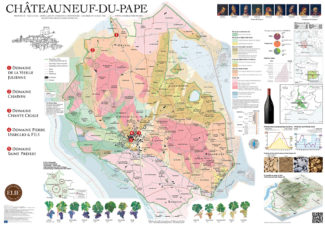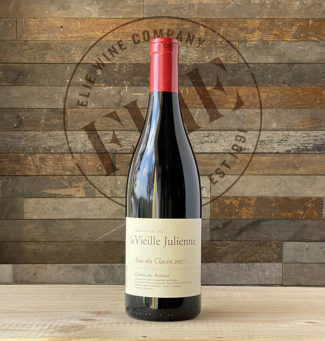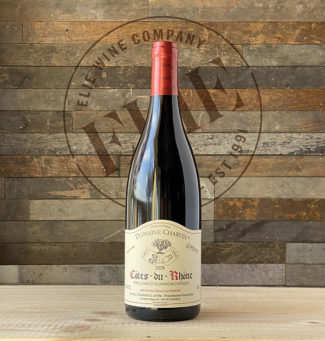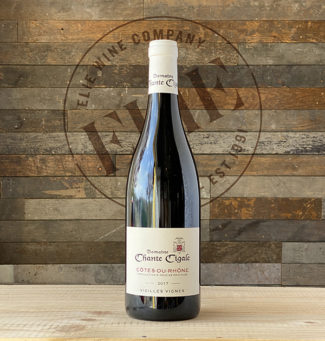Appellation Côtes du Rhône Reds from Five Top Châteauneuf-du-Pape Domaines: Just as AMBITIOUS! (10-Bottle Pack $299, All Included)
Many a storied French château can trace their origins to the Romans—far fewer can boast a heritage dating back to the Greeks. But Marseilles—founded in the Sixth Century BCE as Massalia—is a scant seventy miles south of Châteauneuf-du-Pape, and it was through this ancient port that the Ionian Greeks brought France some of her earliest vines. The Ligurian Celts who occupied Southern Rhône were producing wine five centuries before Julius Caesar drew his first breath.
Although Châteauneuf-du-Pape remains her heart and soul, Southern Rhône slithers across a vast, fecund territory, producing 95% of Rhône Valley’s total wine output. It follows a vinous path beginning in the commune of Montélimar, about 30 miles south of Valence, and extends to the medieval city of Avignon, once the seat of the Catholic popes. The climate here is considerably warmer than it is along the Rhône’s northern banks, and the favored grape varieties are those that thrive best through hot and humid summers. Unlike its northerly neighbor, which relies heavily (and at times entirely) on Syrah, wines from the south are generally blends based on a balance of viniculture’s Holy Trinity—Grenache, Syrah and Mourvèdre—along with a legion of other grapes. These wines often represent tremendous value as well as a diverse tasting experience comfortably described as ‘sunny’ because of the bright fruit and warm herb notes expressed.
Côtes du Rhône AOC is one of the largest single appellation regions in the world, covering millions of acres and producing millions of bottles of wine of varying degrees of quality. In Southern Rhône, it encompasses the majority of vineyards and includes hallowed names like Gigondas, Vacqueyras and Châteauneuf-du-Pape. The latter wines prefer to use their individual, highly specific ‘cru’ names, but the truth is, many generic Côtes du Rhônes may come from plots just outside official ‘Villages’ boundaries—some only across the road or a few vine rows away—and among them, you can find wines with nearly the same level of richness at a fraction of the cost.
Of course, there is more to being an acclaimed appellation than simply terroir; the top producers in the Côtes du Rhône also adhere to a highly restrictive set of rules involving everything from lower than allowed maximum yields per acre to minimum alcohol content without chaptalization to permitted varietals; the requirements for a generic Côtes du Rhône is much less stringent.
The best—and by most accounts, the most reliable—of the many Côtes du Rhône labels is the insignia-embossed Châteauneuf-du-Pape, which hails from a remarkable region between the towns of Orange and Avignon. Named for the castle built by the 14th Century Pope John XXII, this heavily-extracted wine is the template after which most Côtes du Rhône reds model themselves, and in fact, it’s the copycats that persuaded the producers of genuine Châteauneuf-du-Pape producers to apply to the French government to protect their name, making it the first AOC in France. The unique combination of precipitation (Châteauneuf-du-Pape is very dry) and wind (the cool, powerful Mistral blows from the northeast, down the Rhône Valley corridor, and into the Gulf of Lion in the northern Mediterranean) and especially, the large, flat stones known as galets which serve to prevent surface evaporation and reflect sunlight into the canopy. This happens to be conditions ideal for Grenache to realize full potential, and as a result, Châteauneuf-du-Pape is largely built around this grape, typically grown on low bush vines. Syrah adds black-fruit spice, and is grown on cooler higher ground; Mourvèdre brings flesh and acidity, and makes up about 10% of a typical blend. To a decreasing extent, Cinsault is used for aromatics; a total of 13 varieties are permitted, giving the wine a legendary and almost unrivaled complexity. Big-shouldered, occasionally blustery, Châteauneuf-du-Pape wine may, in ideal vintages, be as enjoyable to drink in its youth as it is with age. When young, a core of perfumed fruit tames the tannins and acidity, and tempers into rich leather and smoky, earth-tones as it grows older.
 Limited to five communes, Châteauneuf-du-Pape commands prices worthy of its reputation, but many of the estates own vines just outside the tight borders and there are some plots on which some vineyard rows may be labeled Châteauneuf-du-Pape and adjacent rows, Côtes du Rhône. The finest of these face the challenge of bureaucracy rather than terroir. We firmly believe that the following wines offer extraordinary ‘CdP-esque’ quality at a phenomenal price; they are suited to those who drink for the wine instead of the label. A 10-bottle pack, two of each, for an all-inclusive price of $299.
Limited to five communes, Châteauneuf-du-Pape commands prices worthy of its reputation, but many of the estates own vines just outside the tight borders and there are some plots on which some vineyard rows may be labeled Châteauneuf-du-Pape and adjacent rows, Côtes du Rhône. The finest of these face the challenge of bureaucracy rather than terroir. We firmly believe that the following wines offer extraordinary ‘CdP-esque’ quality at a phenomenal price; they are suited to those who drink for the wine instead of the label. A 10-bottle pack, two of each, for an all-inclusive price of $299.
Domaine de la Vieille Julienne
 Domaine de la Vieille Julienne’s Lieut-dit Clavin exists as a 50-acre plot at the northern limit of Châteauneuf-du-Pape, and indeed, the same vineyard that produces Châteauneuf-du-Pape “Les Trois Sources” (representing the three highest terraces of north-facing Clavin), and “Les Hauts-lieux” (representing the lower terraces), also produces Côtes du Rhône “Lieut-dit Clavin” ($36). A structured and beefy gem, the 2017 showcases dark tannins beneath beautiful, juicy fruit; there are rich and charming notes of blackcurrant jam, black and red licorice and a wreathe of plum and tobacco in an earthen core.
Domaine de la Vieille Julienne’s Lieut-dit Clavin exists as a 50-acre plot at the northern limit of Châteauneuf-du-Pape, and indeed, the same vineyard that produces Châteauneuf-du-Pape “Les Trois Sources” (representing the three highest terraces of north-facing Clavin), and “Les Hauts-lieux” (representing the lower terraces), also produces Côtes du Rhône “Lieut-dit Clavin” ($36). A structured and beefy gem, the 2017 showcases dark tannins beneath beautiful, juicy fruit; there are rich and charming notes of blackcurrant jam, black and red licorice and a wreathe of plum and tobacco in an earthen core.
Domaine Saint Préfert
 On the southern end of Châteauneuf-du-Pape, owner/winemaker Isabel Ferrando was (in her words) ‘born into the howling mistral winds and the singing cicadas.’ Those memories drew her to winemaking after a successful career in banking, and today, she produces wines that consistently score in the 90s. “Clos Beatus Ille” 2019 ($33) is her Côtes du Rhône label, and presents a luscious mouthfeel framed by firm, densely packed tannins and showing crushed red fruits, thyme with black tea and graphite notes.
On the southern end of Châteauneuf-du-Pape, owner/winemaker Isabel Ferrando was (in her words) ‘born into the howling mistral winds and the singing cicadas.’ Those memories drew her to winemaking after a successful career in banking, and today, she produces wines that consistently score in the 90s. “Clos Beatus Ille” 2019 ($33) is her Côtes du Rhône label, and presents a luscious mouthfeel framed by firm, densely packed tannins and showing crushed red fruits, thyme with black tea and graphite notes.
Domaine Pierre Usseglio & Fils
 Founded in 1948 by Italian winemaker Francis Usseglio, the domain released its first vintage the following year. Since then, the family has nurtured 17 parcels over almost fifty acres situated within some of the best terroirs in Châteauneuf-du-Pape, and today, brothers Jean-Pierre and Thierry Ussegliodivide their time between cellar and vineyards, updating technique without compromising the traditional style espoused by their father. They produce world-class Châteauneuf-du-Pape, but also, among the most refined Côtes du Rhône bottlings to be found, especially in this rare and benchmark vintage. The Côtes du Rhône 2016 ($26) is chewy and delectable, with bright red mulberry notes above garrigue and smoke.
Founded in 1948 by Italian winemaker Francis Usseglio, the domain released its first vintage the following year. Since then, the family has nurtured 17 parcels over almost fifty acres situated within some of the best terroirs in Châteauneuf-du-Pape, and today, brothers Jean-Pierre and Thierry Ussegliodivide their time between cellar and vineyards, updating technique without compromising the traditional style espoused by their father. They produce world-class Châteauneuf-du-Pape, but also, among the most refined Côtes du Rhône bottlings to be found, especially in this rare and benchmark vintage. The Côtes du Rhône 2016 ($26) is chewy and delectable, with bright red mulberry notes above garrigue and smoke.
Domaine Charvin
 Laurent Charvin tends vines in the northwest end of Châteauneuf-du-Pape, primarily in Cabrières, Maucoil and Mont Redon. He farms organically, and vinifies old-school, without de-stemming and fermenting in concrete tanks for 21 months before being bottled unfiltered. From a sandy, north-facing hillside, “Le Poutet” 2018 ($26) is an exemplary Côtes du Rhône that shows Grenache elegance with ripe blackberry and mulberry mingled in bramble and spice. The palate is intense and generous and is wonderful testimony to the winemaker’s attention to detail.
Laurent Charvin tends vines in the northwest end of Châteauneuf-du-Pape, primarily in Cabrières, Maucoil and Mont Redon. He farms organically, and vinifies old-school, without de-stemming and fermenting in concrete tanks for 21 months before being bottled unfiltered. From a sandy, north-facing hillside, “Le Poutet” 2018 ($26) is an exemplary Côtes du Rhône that shows Grenache elegance with ripe blackberry and mulberry mingled in bramble and spice. The palate is intense and generous and is wonderful testimony to the winemaker’s attention to detail.
Domaine Chante Cigale
 The roots of this domain extend back to 1874, when the delightfully-named Hyppolite Jourdan christened the estate Chante Cigale, meaning ‘song of the cicada’, as can be heard throughout Southern Rhône. Alexandre Favier currently runs the winery—now expanded to nearly a hundred acres—maintaining the family’s winemaking traditions. “Vieilles Vignes” 2017 ($20) is a showy Côtes du Rhône packed with plush blackberry and rounded blueberry on the palate, with smoky notes in the mid-palate edged by minerality, bright acidity and fine-grained tannins.
The roots of this domain extend back to 1874, when the delightfully-named Hyppolite Jourdan christened the estate Chante Cigale, meaning ‘song of the cicada’, as can be heard throughout Southern Rhône. Alexandre Favier currently runs the winery—now expanded to nearly a hundred acres—maintaining the family’s winemaking traditions. “Vieilles Vignes” 2017 ($20) is a showy Côtes du Rhône packed with plush blackberry and rounded blueberry on the palate, with smoky notes in the mid-palate edged by minerality, bright acidity and fine-grained tannins.
- - -
Posted on 2021.04.29 in France, Wine-Aid Packages, Southern Rhone
Featured Wines
- Notebook: A’Boudt Town
- Saturday Sips Wines
- Saturday Sips Review Club
- The Champagne Society
- Wine-Aid Packages
Wine Regions
Grape Varieties
Aglianico, Albarino, Albarín Blanco, Albarín Tinto, Albillo, Aleatico, Arbanne, Aubun, Barbarossa, barbera, Beaune, Biancu Gentile, bourboulenc, Cabernet Franc, Cabernet Sauvignon, Caino, Caladoc, Calvi, Carcajolu-Neru, Carignan, Chablis, Chardonnay, Chasselas, Clairette, Corvina, Cot, Counoise, Erbamat, Ferrol, Fiano, Frappato, Friulano, Fromenteau, Fumin, Garnacha, Gewurztraminer, Godello, Graciano, Grenache, Grolleau, Groppello, Juan Garcia, Lambrusco, Loureira, Macabeo, Macabou, Malvasia, Malvasia Nera, Marsanne, Marselan, Marzemino, Melon de Bourgogne, Merlot, Mondeuse, Montanaccia, Montepulciano, Morescola, Morescono, Moscatell, Muscadelle, Muscat, Natural, Nero d'Avola, Parellada, Patrimonio, Petit Meslier, Petit Verdot, Pineau d'Aunis, Pinot Auxerrois, Pinot Blanc, Pinot Gris, Pinot Meunier, Pinot Noir, Poulsard, Prieto Picudo, Rondinella, Rousanne, Roussanne, Sangiovese, Sauvignon Blanc, Savignin, Semillon, Souson, Sparkling, Sumoll, Sylvaner, Syrah, Tannat, Tempranillo, Trebbiano, Trebbiano Valtenesi, Treixadura, Trousseau, Ugni Blanc, vaccarèse, Verdicchio, Vermentino, Viognier, Viura, Xarel-loWines & Events by Date
- April 2024
- March 2024
- February 2024
- January 2024
- December 2023
- November 2023
- October 2023
- September 2023
- August 2023
- July 2023
- June 2023
- May 2023
- April 2023
- March 2023
- February 2023
- January 2023
- December 2022
- November 2022
- October 2022
- September 2022
- August 2022
- July 2022
- June 2022
- May 2022
- April 2022
- March 2022
- February 2022
- January 2022
- December 2021
- November 2021
- October 2021
- September 2021
- August 2021
- July 2021
- June 2021
- May 2021
- April 2021
- March 2021
- February 2021
- January 2021
- December 2020
- November 2020
- October 2020
- September 2020
- August 2020
- July 2020
- June 2020
- May 2020
- April 2020
- March 2020
- February 2020
- January 2020
- December 2019
- November 2019
- October 2019
- September 2019
- August 2019
- July 2019
- June 2019
- May 2019
- April 2019
- March 2019
- February 2019
- January 2019
- December 2018
- November 2018
- October 2018
- September 2018
- August 2018
- July 2018
- June 2018
- May 2018
- April 2018
- March 2018
- February 2018
- January 2018
- December 2017
- November 2017
- October 2017
- September 2017
- August 2017
- July 2017
- June 2017
- May 2017
- April 2017
- March 2017
- February 2017
- January 2017
- December 2016
- November 2016
- October 2016
- September 2016
- August 2016
- July 2016
- June 2016
- May 2016
- April 2016
- March 2016
- February 2016
- January 2016
- December 2015
- November 2015
- October 2015
- September 2015
- August 2015
- July 2015
- June 2015
- May 2015
- April 2015
- March 2015
- February 2015
- January 2015
- December 2014
- November 2014
- October 2014
- September 2014
- August 2014
- July 2014
- June 2014
- April 2014
- March 2014
- February 2014
- January 2014
- December 2013
- November 2013
- October 2013
- September 2013
- August 2013
- July 2013
- June 2013
- May 2013
- April 2013
- March 2013
- February 2013
- January 2013
- December 2012
- November 2012
- October 2012
- February 2004
Search



